-Hallo friends, Learn Accounting Coach,
in the article you read this time with the title Accounts Receivable: Statement Of Financial Position / Balance Sheet Statement Of Financial Position Partial, we have prepared this article well for you to read and retrieve the information therein. Hopefully the content of article posts Accounting, which we write this you can understand. Alright, happy reading.
Title : Accounts Receivable: Statement Of Financial Position / Balance Sheet Statement Of Financial Position Partial
link : Accounts Receivable: Statement Of Financial Position / Balance Sheet Statement Of Financial Position Partial
Accounts Receivable: Statement Of Financial Position / Balance Sheet Statement Of Financial Position Partial

Hi, berjumpa kembali, di kesempatan akan menjelaskan tentang statement of financial position partial Accounts Receivable: Statement of Financial Position / Balance Sheet simak selengkapnya
Accounts Receivable is a current benefit account (remember that “current” means they are due within 1 year) shown on the Statement of Financial Position (IFRS)/ Balance Sheet (ASPE). This account represents money that is owed to the company by its debtors, within one year of the reporting date.
As described in the “” article, Accrued Revenue is added to the Accounts Receivable account once the entity has billed the client. In this situation, an entity may have delivered the goods or services, has billed the client, but has not yet received cash for those services.

Examples of journal entries involving Accounts Receivable can be present found below.
When system is rendered/good is delivered, but no charge has been sent:
Once the charge is sent, but no money has been received from the client:
Once the money is received from the client:
Accounts Receivable are also considered Financial Assets. We discuss how to measure different financial assets in greater detail in a later article. But for now, we will focus on what makes Accounts Receivable a Financial Asset and how they are measured.
The ASPE and IFRS criteria for Accounts Receivable are more or less the same, so we will only review the IFRS definitions.
Definition
IAS 32 (IFRS) defines a Financial Asset as either:
Cash, OR
An equity tool from a different entity, OR
A contractual right to receive cash, OR
A contractual right to receive another financial benefit from a different entity, OR
A contract that might be present settled using the entity’s personal equity instruments. (There are some more requirements within this clause that deal with derivatives. For more information note IAS 32.11)
Accounts Receivable are a contractual right to receive cash - making them Financial Assets.
Recognition
IAS 39.14 states that an entity should only recognize the Accounts Receivable when the contractual provisions are met. In other words - we cannot add an amount to the Accounts Receivable balance unless we have rendered the system and/or provided the goods.
Initial Measurement
Accounts Receivable should be present even at the face value of what is agreed upon in the contract. While interest may be present applied to the charge provided payment is late, interest that is expected to be present received should not be present recognized in the Accounts Receivable account. This is because interest is likely to be present immaterial and it is difficult to estimate.
Accounts receivable should also be present recorded at the Net Realizable Value. This is the value that is expected to be present received. In the next article, we review how to account for uncollectible amounts in Accounts Receivable balances.
Subsequent Measurement
Accounts receivable should continue to be present even at Net Realizable Value.
Help improve this article
If you have feedback or questions, please leave a comment in the section below.
Sign Up!
Click our
oke detil mengenai Accounts Receivable: Statement of Financial Position / Balance Sheet semoga tulisan ini bermanfaat terima kasih
Artikel ini diposting pada kategori , tanggal 22-11-2021, di kutip dari https://www.cpasolved.com/post/accounts-receivable-statement-of-financial-position-balance-sheet
Thus the article Accounts Receivable: Statement Of Financial Position / Balance Sheet Statement Of Financial Position Partial
You now read the article Accounts Receivable: Statement Of Financial Position / Balance Sheet Statement Of Financial Position Partial With the link address https://learnaccountingcoach.blogspot.com/2021/11/accounts-receivable-statement-of.html
